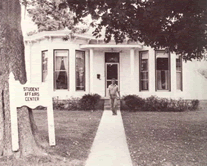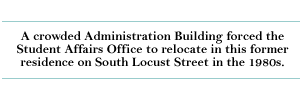
Pages:
<< Back 6
7 8
9 10
11 12
13 14 15
Next >>
When
White was named special assistant to the vice president for academic
affairs in 1985, Anthony Catanese of the economics and business
department became faculty development coordinator. Marion K. McInnes
succeeded Rosenhaus as director of convocations in 1985 and the
next year was given the additional task of coordinating the celebration
of the university's sesquicentennial. Ray H. French, as university
curator, made a detailed inventory of the institution's extensive
art collection before his retirement in 1984. His successor was
Mary La Lone of the sociology and anthropology department.


In 1978 Robert G. Bottoms was appointed to the position of vice
president for university relations, a title changed to vice president
for external relations in 1980 and executive vice president in 1983.
His chief responsibilities lay in the planning and implementation
of the university's development and fund-raising programs. In a
reorganization of this department Frederick Sanders was named director
of planned giving, James N. Kleinschmidt director of development
and alumni relations. Theodore Katula became associate director
of alumni relations in addition to his post as director of student
activities, formerly known as director of the Memorial Student Onion
Building.
Other appointments in development and alumni affairs over the next
few years included John McConnell, John D. Fetters, Debra L. Haerr,
Bruce E. Ploshay, Linda M. Katula, Marsha J. Brown, and Ann Daly.
In the expanded office of public relations under the direction of
Patrick Aikman were Gregory Rice, director of publications and later
university editor; Dian D. Phillips, who succeeded Rice as director
of publications in 1985; Judith C. Magyar, director of summer conferences;
and John McGauley, director of news services.

David
C. Murray became director of admissions in 1978, later adding the
title of assistant provost and finally assistant vice president.
Assisting him in that important office have been William D. Berg,
longtime staffer Richard E. Lyons as associate director of admissions,
Elizabeth A. Napoli, Polly A. Coddington, Veda R. Robinson, and
a series of young admissions counselors, mostly recent DePauw graduates.
Kenneth R. Ashworth succeeded Charles W. Bruce as director of financial
aid in 1982. Registrar Eleanor Ypma added the title of assistant
provost and director of graduate studies.
In its new location in a remodeled residence on South Locust Street,
the student affairs office underwent considerable reorganization.
In 1979 Joan M. Claar became the new dean of students after
Associate Dean Patricia E. Domeier had served as acting dean the
previous year. John R. Mohr continued as an associate dean of students
and director of placement from 1977 to 1982. His successor, Robert
G,. O'Neal, was replaced the next year by Thomas R. Cath, who took
the title of director of career planning and placement. This office
also relocated to more spacious quarters in the Student Union Building,
where it is much frequented by job-conscious students. Rebecca S.
Lamb was named assistant director of career planning and placement
in 1985.
Other members of the student affairs staff in this period have been
husband-and-wife team Carol A. Arner and Thomas D. Arner, presently
associate dean and assistant dean of students, respectively, Vic
Boschini, Janice Simmons, and James W. Schlegel. Supervising the
work of the student dormitory counselors are three residence life
directors, formerly called head resident advisers.
In 1978 the office of comptroller was changed to vice president
for finance, a position filled first by Lawrence Elam and after
1981 by Fred S. Silander. Richard Conrad was manager of the DePauw
Book Store from 1978 to 1986, when he took over the same position
in the Book Store Annex. Successive directors of the physical plant
during this period have been Robert D. Gaston, Bruce V. Collins,
and James Daugherty. In 1984 John Henry was named to the new post
of director of personnel, later adding the title of assistant vice
president for support services.
President Rosser initiated a major change in departmental governance,
replacing a time-honored system of near-permanent, seniority-determined
department heads with chairmen appointed for a three-year term.
In its place he established a system where reappointment was subject
to departmental evaluation and recommendation by the committee on
faculty. This system, which had been foreshadowed by rotating headships
in the history and chemistry departments earlier, brought about
many shifts in departmental leadership and widened participation
in faculty decision-making. The administration also placed strong
emphasis on periodic evaluation of faculty members, both by peers
and by students. It also attempted to establish a program of merit
raises in recognition of superior teaching and professional attainments
that was never fully implemented.


Some departments acquired new titles to reflect more closely the
nature of their course offerings. Physical education was broadened
to health, physical education, and recreation. Economics and business
became economics and management. Earth sciences reverted to its
former title of geology and geography, and astronomy was shifted
from mathematics to the physics department by mutual agreement.
In a return to an older terminology at DePauw, zoology merged with
botany and bacteriology to form the department of biological sciences.
Two casualties of changing student interests and budgetary restraints
were the programs in African Studies and Black Studies, both of
which were phased out early in the Rosser administration.
The Rosser presidency was a time of rethinking the university's
goals and restructuring the curriculum to re-affirm the liberal
arts ideal. In 1979 the faculty adopted a new statement of purpose
and aims, the first such in nearly six decades. While continuing
to stress intellectual inquiry, clear thinking, and effective expression,
the statement also made reference to students' lifestyles, emotional
needs, and career choices. Its philosophy was summed up in the reaffirmation
of a commitment to "academic excellence, growth in personal
and social awareness, and preparation for leadership."
After prolonged committee consideration and faculty debate, a new
set of graduation requirements was put into effect for the College
of Liberal Arts. It involved a division of the distribution requirements
into six newly defined groups: 1) natural sciences and mathematics;
2) social and behavioral sciences; 3) literature and the arts; 4)
historical and philosophical understanding; 5) foreign languages;
and 6) self-expression. Students were to choose two courses from
each of the first five groups and one and a half courses from the
sixth, which included physical education, applied music, studio
art, and certain extracurricular activities. In a compromise, the
original proposal was amended to permit students to omit any two
courses from the six groups. The School of Nursing adopted a slightly
modified version of these graduation requirements.
Back
to Top
Pages:
<< Back 6
7 8
9 10
11 12
13 14 15
Next >>
|






